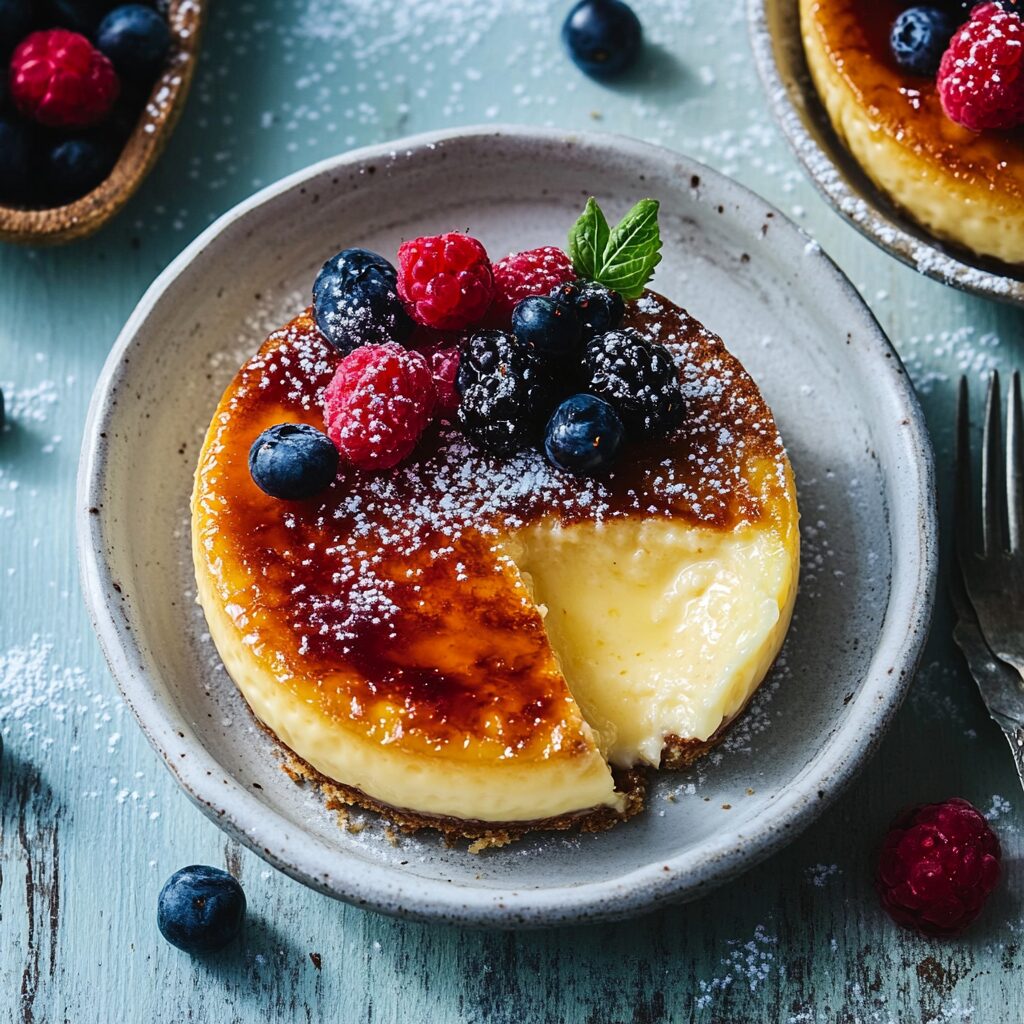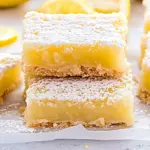This Crème Brûlée is the epitome of indulgence. Its smooth, velvety vanilla custard provides a luxurious base that is perfectly complemented by the crackling top of caramelized sugar. Each bite is an exquisite balance of creaminess and crispness, making it an unforgettable dessert for any special occasion.
For an added touch, consider infusing your custard with other flavors such as coffee or orange zest. This dessert is a classic French treat that’s surprisingly simple to make but guaranteed to impress your guests. Perfect for dinner parties, romantic evenings, or when you simply want to enjoy a moment of sweet indulgence.
Full Recipe
Ingredients:
-
2 cups heavy cream
-
1 vanilla bean (or 1 tablespoon vanilla extract)
-
5 large egg yolks
-
1/2 cup granulated sugar (plus extra for caramelizing)
-
Pinch of salt
Directions:
-
Preheat the oven to 325°F (163°C).
-
In a saucepan, heat the heavy cream and vanilla bean (or vanilla extract) over medium heat until it begins to simmer. Remove from heat and let steep for 10 minutes.
-
Whisk the egg yolks, sugar, and salt in a medium bowl until the mixture is pale and thick.
-
Gradually add the warm cream mixture to the egg yolk mixture, whisking constantly.
-
Pour the custard through a fine sieve into a large bowl, discarding the vanilla bean if used.
-
Divide the custard mixture evenly between four ramekins. Place the ramekins in a baking dish and fill the dish with hot water halfway up the sides of the ramekins.
-
Bake for 40-45 minutes, or until the custard is set but still slightly jiggly in the center.
-
Remove the ramekins from the water and cool to room temperature. Refrigerate for at least 2 hours before serving.
-
Just before serving, sprinkle a thin layer of granulated sugar on top of each custard. Using a kitchen torch, caramelize the sugar until golden brown and crispy.
Prep Time: 15 minutes | Cooking Time: 45 minutes | Total Time: 3 hours (including chilling)
Kcal: 320 kcal | Servings: 4 servings
The Allure of Crème Brûlée: A Classic Dessert Reimagined
Few desserts encapsulate elegance and indulgence quite like crème brûlée. A harmonious contrast between rich, creamy custard and a brittle, caramelized sugar crust, it is a dish that has withstood centuries of culinary evolution. The “Simple Crème Brûlée Dessert” recipe from Allrecipes offers a pared-down, approachable version of this classic French treat, proving that even gourmet desserts can be within reach for home cooks.
But beyond its velvety texture and satisfying crackle lies a story steeped in tradition, innovation, and global appreciation. This article dives into the background of crème brûlée, explores its cultural relevance, highlights popular variations, and offers practical tips for perfecting it in any kitchen.
A Brief History: Origins and Evolution
While crème brûlée is most famously associated with French cuisine, its precise origin is the subject of some culinary debate. The earliest known recipe resembling crème brûlée appears in a 1691 French cookbook by François Massialot, a cook in the kitchens of royalty. Interestingly, similar desserts also emerged independently in England (as “Trinity Cream” at Trinity College, Cambridge) and Spain (as “crema catalana”).
Despite these competing claims, it was French chefs who refined and popularized the version we know today. Traditionally served in individual ramekins, the dessert gained international popularity in the late 20th century, especially in upscale restaurants across Europe and North America.
Cultural Significance and Enduring Appeal
Crème brûlée has long symbolized refined dining and special occasions. Its presence on a menu often signals a chef’s technical prowess, due to the precision required to balance the creaminess of the custard with the crispness of the torched sugar topping.
Beyond restaurants, its simplicity and dramatic presentation have made it a favorite for home celebrations from intimate dinners to holiday feasts. The act of cracking the sugar shell with the back of a spoon is now a sensory ritual relished by dessert lovers worldwide.
What makes crème brûlée so enduring is its dual nature: rich yet light, simple yet sophisticated. The Allrecipes version captures this essence beautifully, streamlining the traditional method while preserving its fundamental character.
The Science Behind the Perfect Crème Brûlée
Crème brûlée is a custard at its core, and achieving the ideal texture is a delicate balance of technique and timing. The custard is typically made with heavy cream, egg yolks, sugar, and vanilla, and then baked in a water bath (bain-marie) to ensure even heat distribution.
One of the reasons this dessert is loved by chefs and food scientists alike is the chemical magic involved in its final step: caramelizing the sugar. Using a kitchen torch to brûlée the sugar creates the signature crunchy topping, thanks to the Maillard reaction a complex browning process that imparts deep flavor and aroma.
Even in the simplified Allrecipes version, these scientific principles remain vital. The custard must be just set not overcooked to avoid curdling, and the sugar must be evenly melted for that iconic glass-like surface.
Popular Variations Across Cultures
While vanilla is the most traditional flavor, crème brûlée’s basic structure makes it highly adaptable. Around the world, chefs have put creative spins on the classic by infusing the custard with local flavors or pairing it with complementary toppings. Here are some popular adaptations:
-
Chocolate Crème Brûlée: Adds cocoa or melted chocolate to the custard for a rich, bittersweet twist.
-
Coffee or Espresso: Infuses the cream with coffee for a sophisticated, slightly bitter edge.
-
Lavender or Earl Grey: Floral and herbal notes bring an aromatic complexity.
-
Citrus Zest: Orange or lemon zest can brighten the dish and cut through its richness.
-
Coconut Milk or Almond Milk: Used for dairy-free alternatives, offering nutty undertones.
-
Seasonal Fruit Garnishes: Berries, figs, or even poached pears can be added to balance sweetness.
The versatility of crème brûlée ensures that it remains a canvas for both traditionalists and modernists in the kitchen.
Expert Tips for Home Bakers
While the Allrecipes version simplifies the process, a few extra tips can elevate the end result:
-
Use a Kitchen Torch: Although broiling in the oven is possible, a kitchen torch offers better control and prevents the custard from overheating.
-
Strain the Mixture: Pouring the custard through a fine mesh sieve removes any egg solids or air bubbles, leading to a smoother texture.
-
Choose the Right Ramekins: Shallow, wide ramekins help the custard cook more evenly and provide a larger surface for caramelization.
-
Mind the Water Bath: Ensure the water comes at least halfway up the ramekins and is hot when placed in the oven to create gentle, consistent heat.
-
Cool Completely: Let the custard chill for at least two hours or overnight before brûléeing the sugar to ensure it sets properly.
-
Even Sugar Layer: Use superfine sugar for a more consistent crust and spread it evenly before torching.
By adhering to these guidelines, even novice bakers can achieve restaurant-quality results.
Why This Recipe Works
The Allrecipes “Simple Crème Brûlée Dessert” condenses the complexity of the dish into an accessible format. It uses a microwave to warm the cream a convenient alternative to stovetop heating and a standard oven for baking. The step-by-step approach ensures that even those new to crème brûlée can tackle it with confidence.
Perhaps most importantly, the recipe avoids unnecessary complications. By sticking to classic ingredients and straightforward techniques, it allows the dish’s core appeal to shine: a luscious custard beneath a crackling sugar shell.
Conclusion:
Crème brûlée is more than just a dessert it’s an experience. From the first shattering of the caramel top to the last spoonful of velvety custard, it offers a sensory journey that combines flavor, texture, and nostalgia.
The Allrecipes version proves that you don’t need to be a professional chef or have a culinary degree to enjoy this timeless classic. With a few tools, some patience, and an appreciation for culinary tradition, anyone can recreate this iconic dish at home.
As global tastes evolve and home cooking continues to embrace both tradition and innovation, crème brûlée remains a fixture on the dessert table not because it is complex, but because it is profoundly satisfying. Simple, elegant, and endlessly adaptable, it is a dish that will always have a place in the hearts (and menus) of food lovers everywhere.






